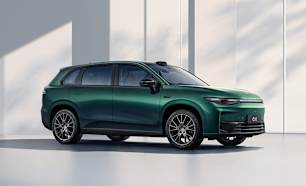The Mahindra boasts a versatile, practical cabin - not something all mid-size seven-seat SUVs can claim.
This grade has electric ‘smart’ door handles that pop out when the car is unlocked. They’re not super easy to grab and feel a little gimmicky.
The sunroof has a solid power-operated blind, unlike an increasing number of models that come with a flimsy sheer blind or no blind at all, which is unimaginable in our hot Australian climate. Thank you, Mahindra!
Another cool feature is the extendable sun-visors that are great at blocking out sun at the front or side, especially on longer drives.
A chunky rear centre headrest impedes rear visibility, but it is easily removed. However the rear outboard headrests are also big and that impacts vision out the large rear side windows.
Great to see Mahindra has retained physical controls for the air conditioning, although if you want to adjust anything digitally, you can via the central screen.
Sitting under that and the air vents are buttons for the reversing camera, hazard lights and other controls, then there’s a wireless phone charger, an extra little slot for your phone and two USB-A ports. No USB-C up front in the XUV700.
There’s decent storage up front with two compact, squarish cupholders in the console, a small central bin with a handy rubber key holder, while the glove box is a decent size and will fit more than just the manual.
Bottle storage in the front doors is excellent. The tall CarsGuide bottle fits easily and there’s extra storage for a bunch of other items.
The front seats are on the firm side but the side bolstering is good, helping you feel nicely secured. The base makes you feel like you’re sitting on the car rather than in it. There’s not a great deal of adjustability - you can’t extend the under-thigh cushion - but the Mahindra has Mercedes-Benz-style controls on the door.
The multimedia screen houses a lot of functions. If you tap the bottom of the screen the climate controls including seat heating pop up. There are more functions if you tap the top of the screen like sound, camera view and the like.
The multimedia screen homepage has tiles, one says ‘Fun in XUV700’ (for Android Auto, Apple CarPlay and radio) and the other says ‘Fun with XUV700’ (vehicle performance).
Driver assist functions are accessible via the driver’s instrument display using the steering wheel-mounted controls and you can change the intensity of cruise control and lane keep assist or turn off functions like traffic sign recognition and smart pilot assist.
There are a few cons up front. The indicator sound is awful and makes it feel cheap. There are some quality issues, like the flimsy panel to the lower right of the steering wheel that’s home to the auto stop-start. It feels like it’s going to fall off. And some of the fabrics don’t quite line up.
The device charger could do with a fan as my phone gets super hot charging on the pad, while the ‘Siri’ talk-to-text function of Apple CarPlay is patchy.
In the second row, the legroom is decent and while there’s not acres of room I don’t feel cramped sitting behind my 183cm (six-foot) driving position. A tiny transmission tunnel means good centre seat legroom. There’s a lever on the front passenger seat back allowing rear passenger behind to move that seat forward.
Headroom is also decent without being ample. There’s about an inch between my head and the roofliner.
The window line is low enough for small children to see out but not so low you feel like you’re sitting on the car.
The rear seating row is comfortable enough but the backrests - which recline - are flat.
You’ll find rear knee-level air vents, one USB-C port (the only ‘C’ port in the car) and a pair of map pockets, a phone slot under the vents, a centre armrest with two cupholders and loads of door storage for big bottles and more.
For child seats, the two outboard seats have ISOFIX anchors and there are two top tethers as well.
Access to the third row is much easier than I expected for a mid-size seven seater. The passenger-side single outboard seat tumbles flat then up, leaving plenty of space to get into the rear. There’s even a grab handle to assist.
Headroom isn’t great back there for me, but again, I am six-foot tall. A kid will be fine. There’s a surprising amount of legroom and toeroom.
Third-row occupants have access to cupholders and air vents on both sides, a fan speed dial, speakers and a 12-volt outlet that is also accessible from the boot when the seats are lowered.
The fact the curtain airbags cover the third row is a big tick. Overall, a solid third-row experience.
There’s a handy plastic lever on the rear of the seats to lower and raise the third row easily. They don’t quite fold flat into the boot floor so they sit up a little, but don’t intrude on boot space.
It looks like there is a cargo cover option but it wasn’t fitted to this example of the car. There are lots of hooks in the boot to hold bags, but note there is no power tailgate - it’s a manual operation in the Mahindra.
You also get a temporary spare wheel housed externally on the underside of the car.
One thing I can’t tell you unfortunately is the boot volume. Mahindra doesn’t provide those figures. I can say that when all three rows are in place, there is not much room behind the third row. Just enough for three backpacks or a few bags of shopping in a row. When the third row is lowered, there’s ample luggage space.




















.png)





.png)


.png)

.png)

.png)



.png)

.png)
.png)

.png)


.png)




.png)









































.png)




.png)







.png)


















 copy.png)



















.png)























